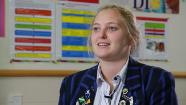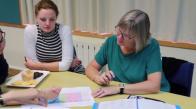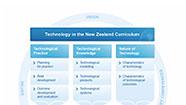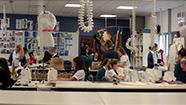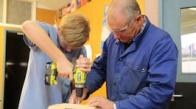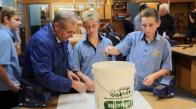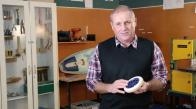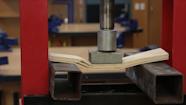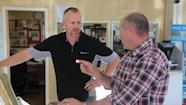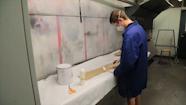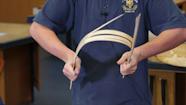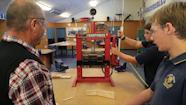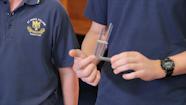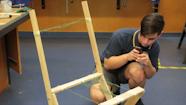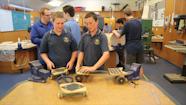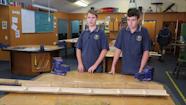Abby Dingle discusses materials and tools that engage students in product design.
Engaging contexts in product design
Transcript
Abby Dingle: We decided on the term "product design" as opposed to "workshop" because it encompasses a lot more of the design technology process, as opposed to calling it workshop. It’s very restricted and infers that it could just be a practical element, whereas with the product design it shows that you’re encompassing the whole of the technological experience and multiple materials to work with as well.
When I arrived here last year we were lucky enough to have glass kilns. We’ve got glass facilitators here, gas tanks for welding and brazing. We have wood workshops, so when I came here even though I didn’t know a lot about glass I’ve taken that opportunity to build up that knowledge and then kind of staying five steps ahead of the kids as we’re going and almost sometimes learning together as well.
We’re really lucky here to have so many materials, tools, techniques, processes available to us. We have a glass programme which we can implement. We’ve got a large kiln a small kiln and a manual kiln which we make use of. We do wood working. We do metal work, silver smithing and we’ve also been lucky enough to have a laser cutter this year, so we’re building into our programmes at the moment the use of computer-aided design and computer-aided manufacture, which is obviously a lot more relevant to girls when they would get out into the industry. Kind of a touch of how it really works.
I came to Dio being quite specialised with wood work and CAD/CAM work, especially on the laser cutter. So I’ve kind of brought that knowledge with me and built that into our programmes. Especially having the laser cutter this year is good, because it means I don’t have to out source which is great. Working with the glass, working with silver smithing and any other bits and pieces I’m picking up along the way as I go, so I’ve either learnt from colleagues or technicians in courses that are run throughout the city.
At the moment I am looking at questionnaires and survey monkeys online speaking to the girls and finding out what’s working and what’s not, what they want to do, what are they interested in. So the girls are all really aware of what happens across technology and then potentially from that I can pick bits out of each different programme and put it into one, especially for the seniors. I’ve been looking at where I can really home in on engaging all of my students and I’m doing this in a number of ways. I’m making sure that I’m covering more of the crafty element, so more of the creative artistic side with the hands-on skills.
I’m also covering CAD/CAM work with my year groups as well, just to make sure that I’m getting to the girls that are more, not necessarily engineery type, but are more industrial thinkers as opposed to the hands-on practical ability. They are going to realise technology’s worth, not just in a crafty concept, but also through a computer-aided design industrial field also.
Related videos
A year 13 student talks about her career pathways (00:55)
A student shares about combining her interests in law and food technology.
School-wide programme planning (04:18)
Cheryl Pym explains how collaboration forms the foundation for school-wide planning in technology education.
Reviewing programme planning in years 7–13 (03:23)
At Diocesan School planning focuses on technology components for years 7–10, and establishing scholarship potential in year 13....
Review of curriculum implementation (03:49)
Margaret van Meeuwen explains how a cycle of self-review has enhanced delivery of curriculum.
A technology department with a digital and design focus (04:13)
Julie Clement shares how a design focus has engaged her students.
Combining knowledge and practice (01:58)
Steve Andrew explains how understanding materials is essential for effective technological practice.
Linking hands-on experiences and understandings (03:54)
Hands-on experiences allow the students to see materials understandings in action.
Play, experiment, explore (02:55)
Steve Andrew lets the students see, feel, and play with products to develop their understandings in materials.
Finding materials to meet the specs (02:36)
Steve Andrew shares how students identify material specifications in a brief and then test materials to find those that are suitable....
School–industry relationship cuts both ways (03:36)
Steve Andrew and Terry Rillstone describe the way the relationship between St John's College and The Shop has benefits for them both....
Pushing the boundaries with materials (02:53)
Steve Andrew describes how his senior students have the confidence to select and work with unfamiliar materials.
Exploring unfamiliar materials (02:44)
Year 12 students from St John's College describe what they know about bamboo and how they are applying this knowledge to their projects....
Students and teachers talk about testing materials in year 11.
Manipulating, forming, and transforming
Students in year 10 describe manipulating, forming, and transforming materials.
Evaluating materials for an outcome
Steve Andrew and students talk about using their knowledge to test materials for their projects at year 12.
Year 10 students describe some of the attributes for the snake skates they are developing.
Senior students select their own issues
Year 12 students talk about the issues that they have selected for their projects.

